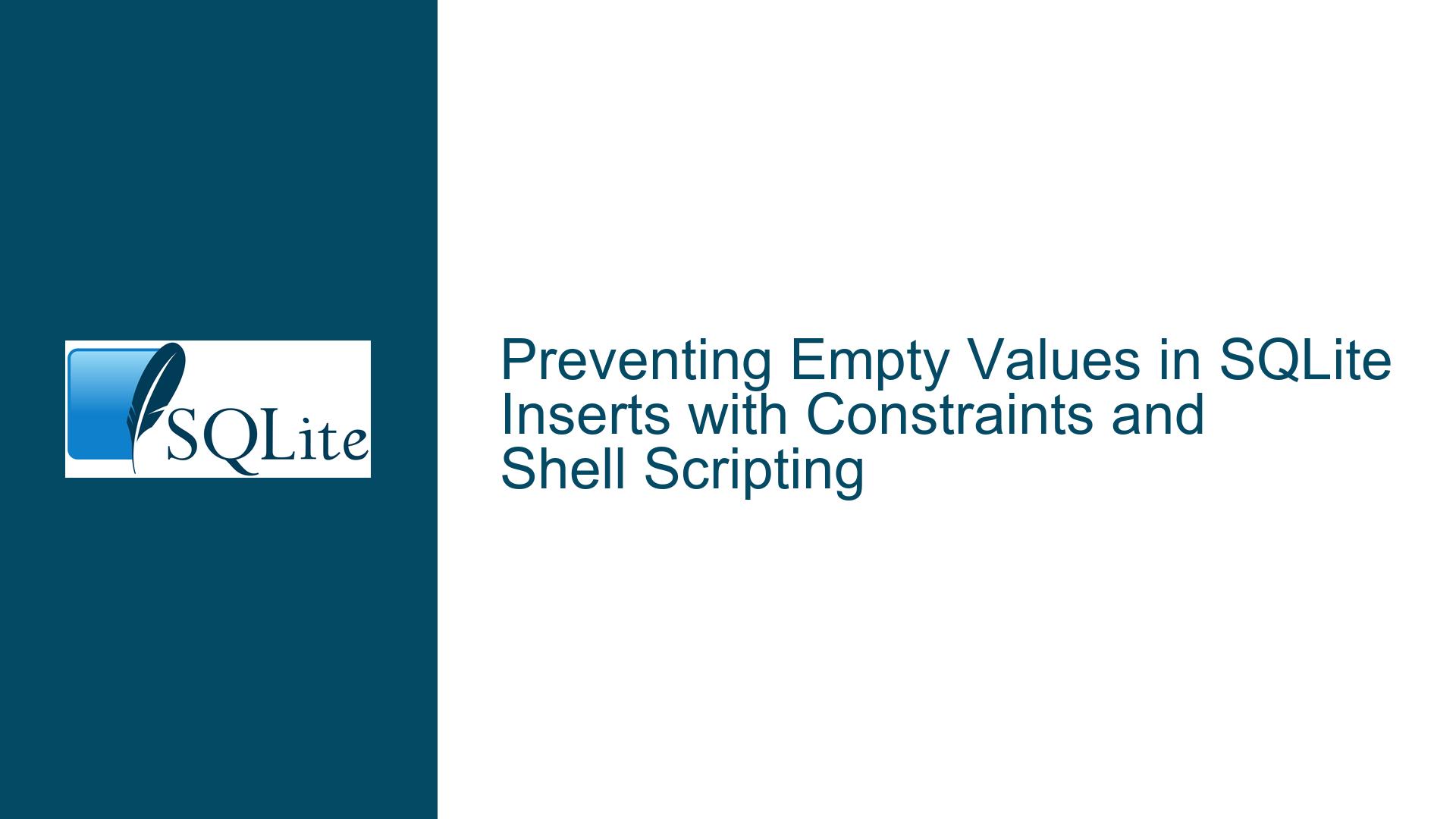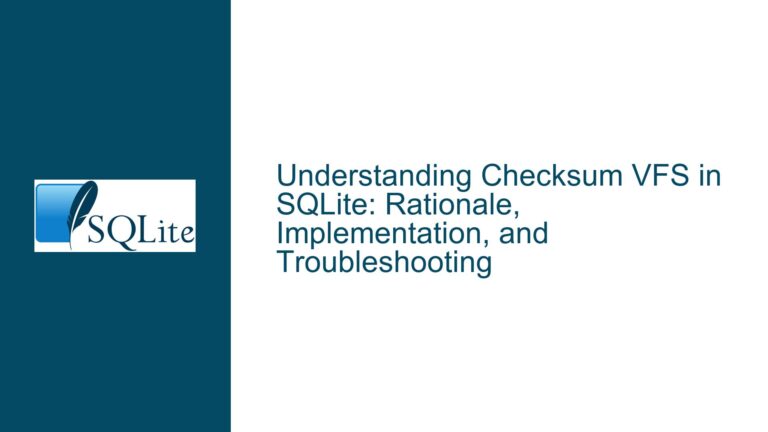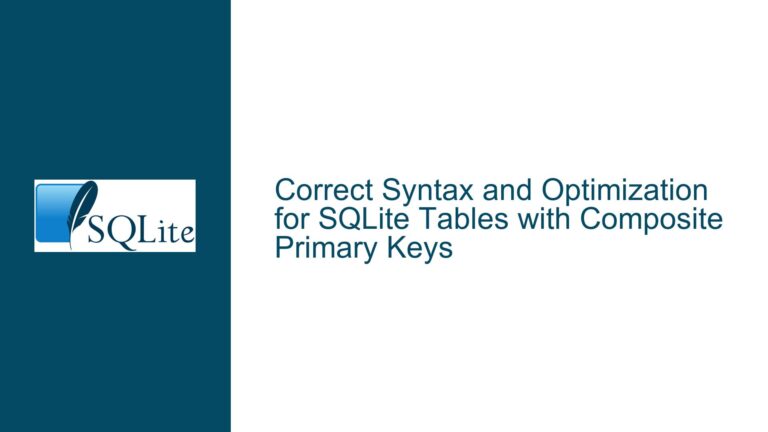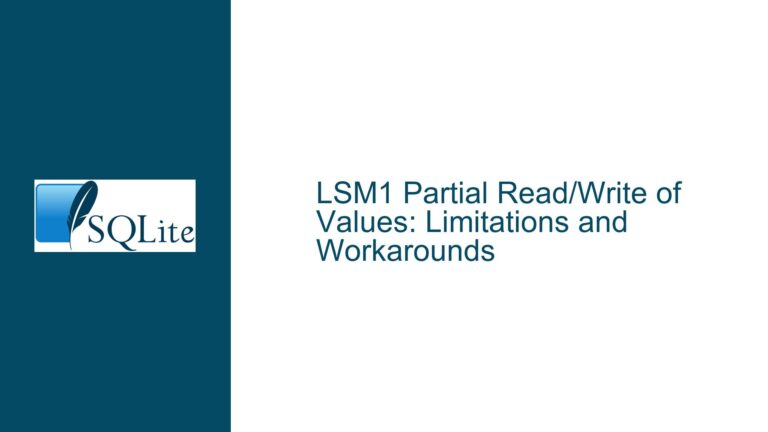Preventing Empty Values in SQLite Inserts with Constraints and Shell Scripting
Empty Values in SQLite Inserts Despite NOT NULL Constraints
When working with SQLite, a common issue arises when attempting to prevent the insertion of empty values into a table. While the NOT NULL constraint is often used to enforce non-null values, it does not inherently prevent empty strings ('') from being inserted. This can lead to unexpected behavior, especially when dealing with shell scripts that dynamically generate SQL queries. For example, if a variable in a Windows shell script evaluates to an empty string, the resulting SQL query may insert an empty value into a column, even if the column has a NOT NULL constraint. This occurs because an empty string is not considered NULL in SQLite; it is a valid, albeit empty, TEXT value.
The confusion often stems from misunderstanding the distinction between NULL and an empty string. In SQLite, NULL represents the absence of a value, while an empty string is a valid TEXT value that happens to have zero length. This distinction is critical when designing constraints to enforce data integrity. Additionally, the use of shell scripts to generate SQL queries introduces another layer of complexity, as variables that are undefined or empty can lead to unintended SQL behavior. This issue is further compounded by the risk of SQL injection if input values are not properly sanitized.
To address this problem, a combination of SQLite constraints and careful input validation in the shell script is required. The goal is to ensure that empty values are rejected at the database level, while also preventing SQL injection vulnerabilities. This post explores the root causes of this issue, provides detailed explanations of the relevant SQLite constraints, and offers step-by-step solutions to enforce the desired behavior.
Misconfigured Constraints and Shell Script Variable Handling
The core issue lies in the misconfiguration of SQLite constraints and the handling of variables in shell scripts. When a column is defined with a NOT NULL constraint, SQLite ensures that the column cannot contain NULL values. However, this constraint does not prevent empty strings, as they are considered valid TEXT values. To reject empty strings, a CHECK constraint must be added to the column definition. For example, a column defined as col2 TEXT CHECK(col2 != '') will reject both NULL and empty string values.
In the context of shell scripting, variables that are undefined or empty can lead to the insertion of empty strings. For instance, in a Windows shell script, the command INSERT INTO tab (col1, col2, col3) VALUES ('%val1%', '%val2%', '%val3%') will insert empty strings if any of the %val% variables are undefined or empty. This behavior occurs because the shell substitutes undefined variables with empty strings by default. To prevent this, the script must explicitly check for empty variables before constructing the SQL query.
Another contributing factor is the lack of input sanitization, which exposes the script to SQL injection attacks. If the script directly incorporates user input into SQL queries without proper validation, malicious input could alter the query’s behavior. For example, an attacker could inject SQL commands by manipulating the %val% variables. To mitigate this risk, parameterized queries should be used instead of directly embedding variables into SQL statements.
The interplay between SQLite constraints and shell script variable handling requires a thorough understanding of both systems. Missteps in either area can lead to data integrity issues or security vulnerabilities. The following section provides detailed troubleshooting steps and solutions to address these challenges.
Enforcing Non-Empty Values with CHECK Constraints and Parameterized Queries
To prevent the insertion of empty values in SQLite, the first step is to define appropriate constraints at the database level. A CHECK constraint can be added to a column to reject empty strings. For example, the following table definition ensures that col2 cannot be empty:
CREATE TABLE tab (
col1 TEXT,
col2 TEXT CHECK(col2 != ''),
col3 TEXT
);
This constraint ensures that any attempt to insert an empty string into col2 will result in an error. However, this approach alone is insufficient if the shell script does not validate its variables before constructing the SQL query. To address this, the script must explicitly check for empty variables and handle them appropriately. For example, in a Windows shell script, the following logic can be used to reject empty variables:
IF "%val2%"=="" (
echo ERROR: val2 is empty
exit /b 1
)
This check ensures that the script exits with an error if %val2% is empty, preventing the insertion of empty values. However, this approach does not protect against SQL injection. To mitigate this risk, parameterized queries should be used. The SQLite shell provides the .parameter command, which allows for safe parameter binding. For example:
.parameter set @val1 '%val1%'
.parameter set @val2 '%val2%'
.parameter set @val3 '%val3%'
INSERT INTO tab (col1, col2, col3) VALUES (@val1, @val2, @val3);
This approach ensures that the values of %val1%, %val2%, and %val3% are safely bound to the query parameters, preventing SQL injection. Additionally, the CHECK constraint ensures that empty values are rejected at the database level.
For more complex scenarios, such as conditional inserts or updates, the CASE expression can be used to handle empty values. For example, the following query inserts NULL if %val2% is empty:
INSERT INTO tab (col1, col2, col3) VALUES (
'%val1%',
CASE WHEN '%val2%' = '' THEN NULL ELSE '%val2%' END,
'%val3%'
);
This approach leverages SQLite’s CASE expression to conditionally insert NULL for empty values, which will be rejected by the NOT NULL constraint. However, this method still requires careful handling of variables in the shell script to prevent SQL injection.
In summary, the combination of CHECK constraints, input validation in shell scripts, and parameterized queries provides a robust solution to prevent the insertion of empty values in SQLite. The following table summarizes the key steps and their benefits:
| Step | Description | Benefit |
|---|---|---|
Define CHECK constraints | Add CHECK(col != '') to reject empty strings | Ensures data integrity at the database level |
| Validate shell script variables | Check for empty variables before constructing SQL queries | Prevents insertion of empty values |
| Use parameterized queries | Bind variables to query parameters using .parameter | Protects against SQL injection |
Leverage CASE expressions | Conditionally handle empty values in SQL queries | Provides flexibility in handling edge cases |
By following these steps, you can ensure that your SQLite database rejects empty values while maintaining security and data integrity. This approach is particularly valuable when working with shell scripts, where variable handling and SQL injection risks are common challenges.






